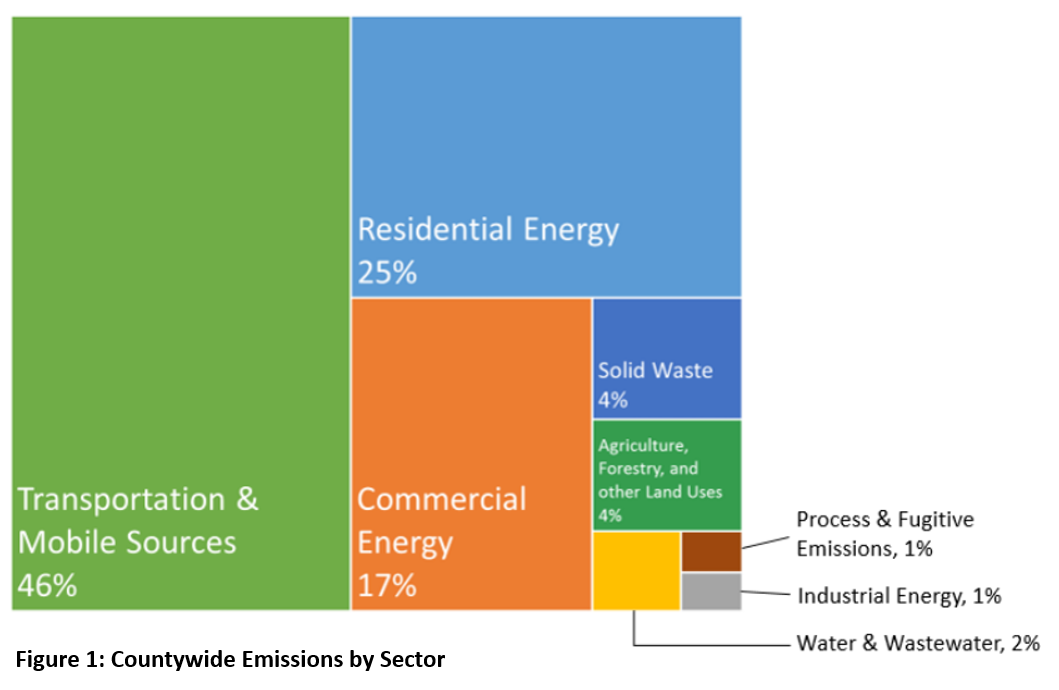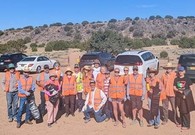Sustainability Office Presents Community-wide Greenhouse Gas Emissions Inventory
On June 14, the Sustainability Office presented the results of a community-wide greenhouse gas emissions inventory before the Board of County Commissioners. The purpose of this inventory is to inform the County’s community-wide climate action plan by identifying key emission sources throughout the community. Emissions were calculated for 2019 to set a baseline during a “business as usual” scenario, before the pandemic altered local travel and activities. Staff partnered with ICLEI – Local Governments for Sustainability, which provides emission management support to local governments, to prepare the inventory.
The inventory documents emissions from residential, commercial, and industrial energy use; transportation fuel use; solid waste management; water and wastewater management; fugitive emissions from natural gas distribution; and agriculture and forest disturbances.
Overall, per capita emissions in Santa Fe County were lower than the national average. However, the inventory revealed several opportunities for improvement. Transportation (e.g., passenger vehicles, freight vehicles, rail, public busses) made up nearly 46% of the greenhouse gas emissions in Santa Fe County (see Figure 1 below). Gasoline powered passenger vehicles alone were the single largest source of emissions, responsible for 29% of all inventoried emissions in the County. The issue of high transportation emissions is intertwined with land use and access to public transportation, walking paths, and biking trails. It is also entangled with rising housing costs, which force workers to commute longer distances. Nearly 40% of workers commute from outside of Santa Fe County, with 22% of those having a commute that is longer than 50 miles. There is tremendous opportunity to reduce transportation emissions through collaborative land use planning to create environments where the community can live and work without heavy reliance on a vehicle.
Residential and commercial energy use were also significant contributors to greenhouse gas emissions, making up 25% and 17% of emissions in the County respectively. The County has committed to reducing emissions from buildings community-wide by 60% by 2030 as part of its Race to Zero pledge. Expanding access to renewable energy sources and energy efficiency upgrades will play a key role in reaching this goal. Energy efficiency upgrades are already underway throughout County facilities. New Mexico’s new community solar program will also help to expand access to renewable energy by giving community members an option to subscribe to a renewable energy facility to offset their energy consumption.
 |
The community-wide greenhouse gas emissions inventory provides a snapshot of key emission sources in the County and will inform emission reduction actions going forward. Gathering this information is an important step in creating a community-wide climate action plan to mitigate the effects of climate change, increase community resiliency, and enhance social equity. This presents an opportunity for us all to join together to protect our planet!
Click here to watch a video of the inventory presentation at the Board of County Commissioners meeting (presentation begins at 2 hr. and 21 min.)!
Composting in Santa Fe County

Food and yard trimmings together accounted for over 33% of municipal solid waste generated in the United States in 2018 and made up over 31% of the waste that was landfilled. Once in the landfill, these materials generate methane, a potent greenhouse gas, while decomposing. Composting vegetable scraps and yard trimmings is an excellent way to divert these materials from the landfill and reduce your carbon footprint while creating a rich soil amendment for your garden!
Compost is simply decomposed organic material, like yard trimmings and vegetable scraps. Finished compost can be added to your garden to nourish plants and help sandy soils retain water. You need four ingredients for successful composting: 1) organic material, 2) moisture, 3) oxygen, and 4) bacteria. Organic material can consist of dead leaves, twigs, lawn clippings, coffee grounds, and vegetable scraps. In our dry climate, you may need to occasionally mix a little water into your compost pile ensure the pile stays moist and to speed decomposition. The pile should be about as damp as a wrung-out sponge. Turn your compost pile regularly to ensure there is sufficient oxygen to allow beneficial bacteria to break down the organic material.
Compost piles can take many forms. You can construct your own using wire fencing or straw bales, or you can purchase a compost container or tumbler.
Worried about smells and attracting hungry animals? Check out these tips for a tidy compost!
-
Managing odors: Those who are new to composting often raise concerns about odor. However, separating kitchen scraps from the rest of your garbage can actually help your kitchen smell better! Inorganic material, like plastic packaging, in your garbage can prevent organic materials from decomposing properly. This creates that awful trash smell. Separating organic materials for composting can help to prevent this. A well-functioning compost system containing properly decomposing organic materials will typically smell slightly earthy. Often times, a compost pile with a bad odor is not getting enough oxygen or is too wet. Turning your compost pile or adding dry materials (e.g., leaves, twigs) can help address this.
-
Keeping the wildlife away: Attracting curious animals is another common concern. There are a number of ways to keep wildlife out of your compost. First, avoid placing meat, cheese, or fats in your compost. Add any food scraps to the center of your compost pile and bury them. Regularly turning your compost pile will also help to speed up decomposition and deter wildlife. You can also discourage animals from investigating your compost by opting for an enclosed design, such as a raised compost tumbler. Finally, locate your compost away from trash cans, fruit trees, or other outdoor food sources.
Check out the Sustainability website for more composting tips!
|
What Can You Do? Adopt a road!

Looking for a fun way to help your community and keep Santa Fe County beautiful? Join Santa Fe County’s Adopt-a-Road and Community Clean-up programs!
This spring, the Tano Road Association, El Rancho de Las Golondrinas, residents of la Puebla, La Cieneguilla neighbors, and Eldorado 285 Recycles organized clean-ups around the county. Together, these groups collected over 180 bags of trash!
The Adopt-a-Road and Community Clean-up programs are open to everyone, including individuals, homeowners associations, youth groups, nonprofit organizations, community groups, and local businesses. Here is how to get involved:
-
Contact the Sustainability Office to identify a county road or public space to clean up.
-
Schedule your clean-up event. Once your clean-up event has been approved, Santa Fe County will provide you with supplies, including trash bags, gloves, and safety vests.
-
Let us know how your event went! Send the County photos, the number of volunteers, and the number of trash bags you’ve collected. The County will arrange to pick up bagged trash after approved clean-up events.
Adopt-a-Road participants who commit to regular clean-ups are eligible to receive a sign recognizing their participation to place along their adopted roadway.
Click here for more information and sign up to make a difference!
|
|